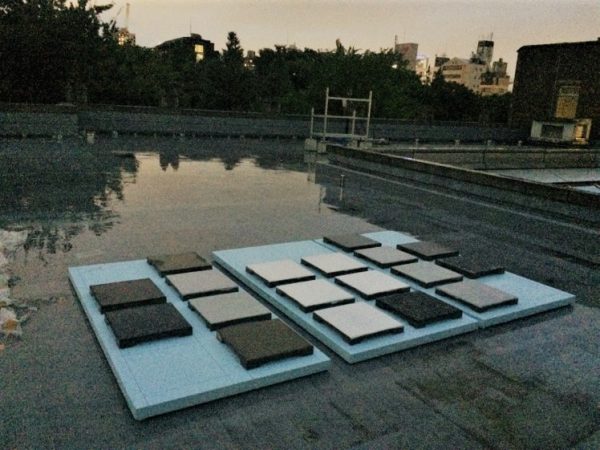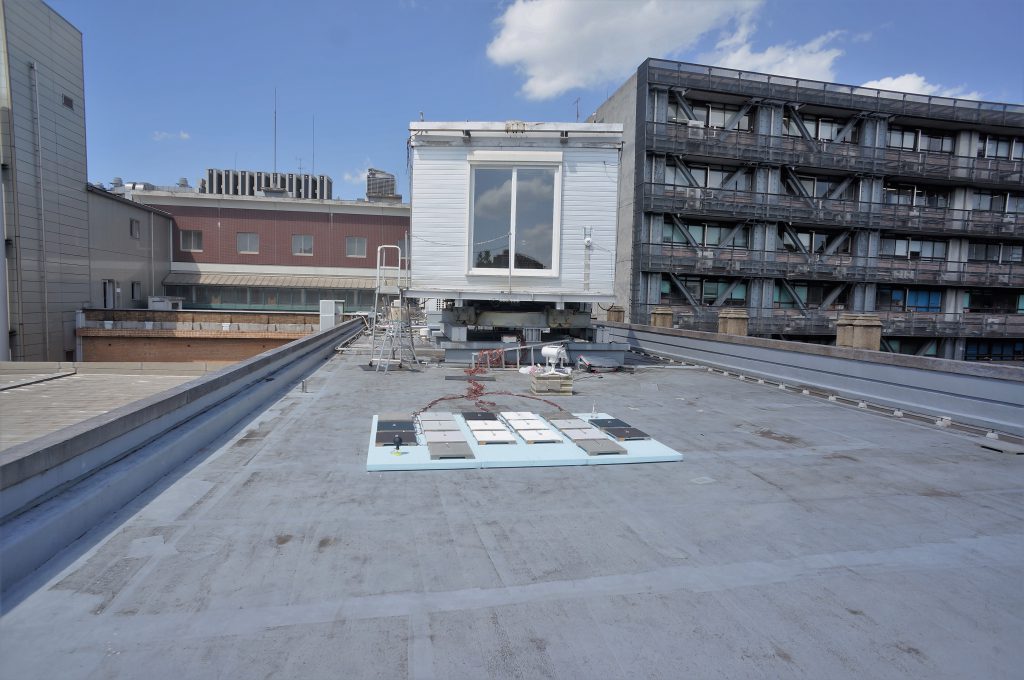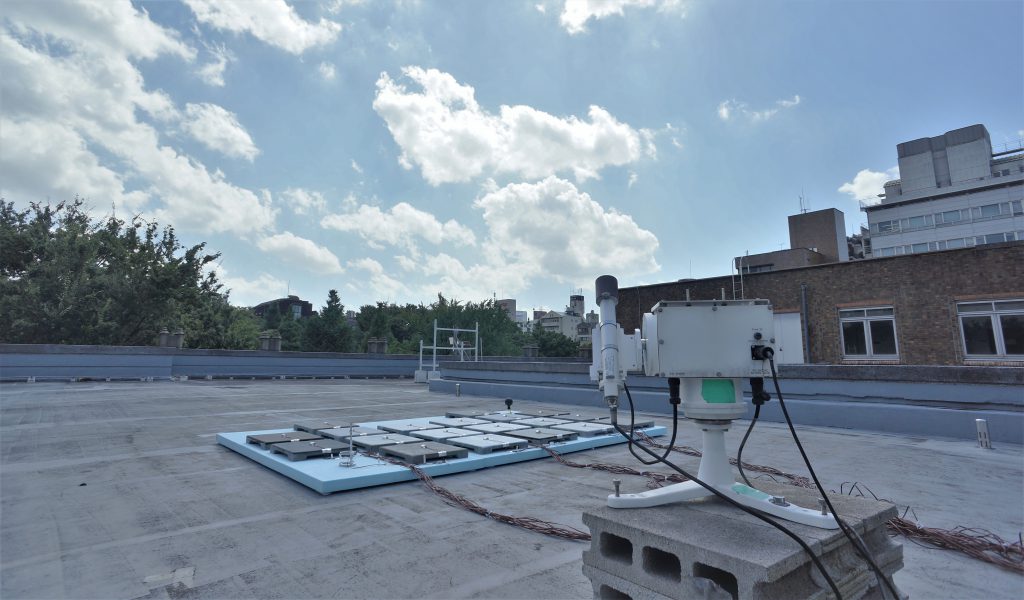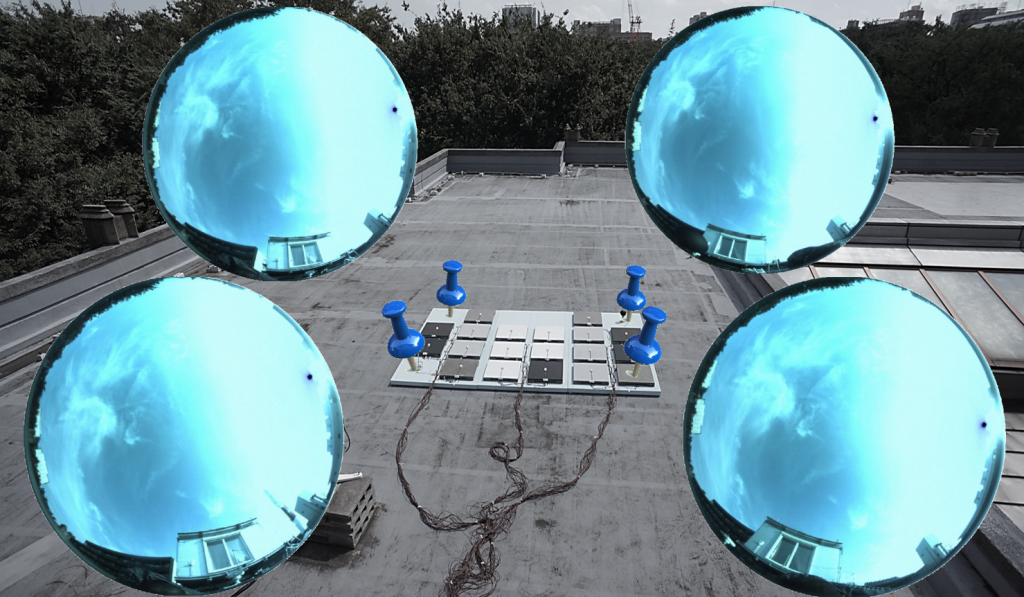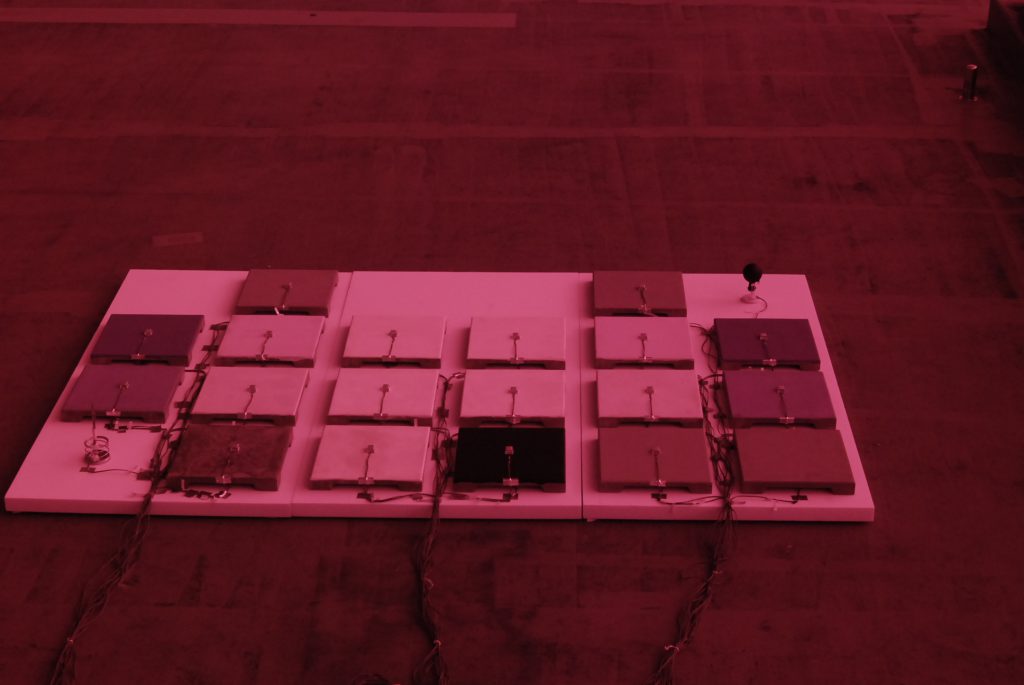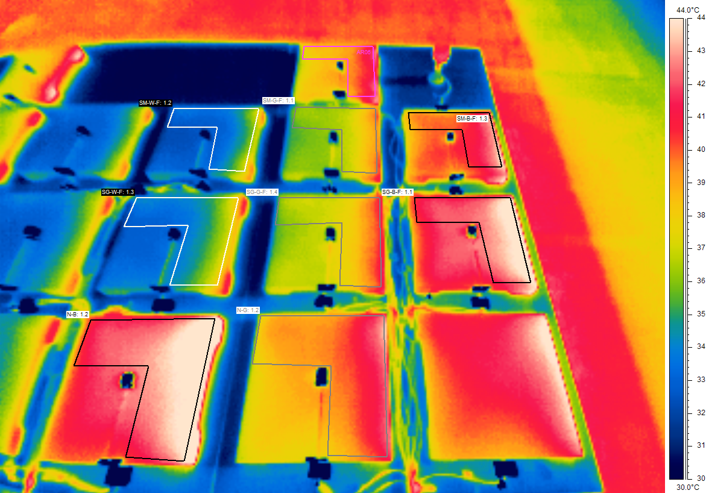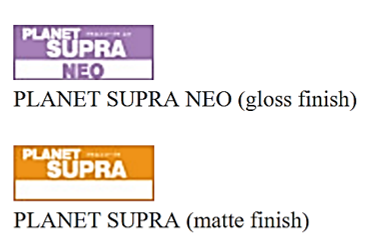English
2017- H.B. Kim, M. Mae, Y. Choi, T. Kiyota, Experimental analysis of thermal performance in buildings with shape-stabilized phase change materials, Energy Build. 152 (2017) 524–533.http://doi:10.1016/j.enbuild.2017.07.076.
Abstract: Maintaining constant thermal conditions in building interiors requires substantial energy. Using phase-change materials (PCMs) with construction materials can improve thermal performance without increasing energy expenditure. Herein, shape-stabilized PCMs (SSPCMs) were used. We measured the thermal performance of a PCM sheet and established the melting- and solidification-temperature ranges at 19–26 °C. Three identical huts were examined using varying PCM levels under natural and heating conditions. In Hut A, no SSPCM sheets were applied; in Hut B, four layers of SSPCM sheets were applied to the floor; in Hut C, one layer of SSPCM was applied to the floor, walls, and ceilings. The results demonstrated that the application of SSPCM sheets improves thermal performance. For an equal number of SSPCM sheet layers applied on each side, the floor directly exposed to solar radiation showed the highest indoor temperature stabilization effect, followed by the walls and ceilings. Compared with Hut A, which served as the reference, the total power consumption using a heater decreased by 9.2% and 18.4% in Huts B and C, respectively. The effect of reducing heating power doubled when the applied area was expanded from the floor to the entire surface. Hence, effective PCM usage can entail large-scale application of SSPCM sheets to building surfaces.
2017- H.B. Kim, M. Mae, Y. Choi, Application of shape-stabilized phase-change material sheets as thermal energy storage to reduce heating load in Japanese climate, Build. Environ. 125 (2017) 1–14. http://doi:10.1016/j.buildenv.2017.08.038.
Abstract: A shape-stabilized phase-change material (SSPCM) was installed on the floor, walls, and ceiling of various buildings, and its effects on indoor room temperature stabilization and heating load reduction were examined using experiments and simulations. The PCM model was developed based on the specific heat capacity of the SSPCM sheets measured using a thermostatic chamber and simulations results were obtained using EnergyPlus. The validity of the PCM model was examined by comparing the simulation and experimental results, which showed similar temperature tendency. The model was then examined to determine the applicability of PCM to the various climates in Japan through annual heating load simulations. The target buildings were classified as Type A (no PCM, reference), Type B (only the floor contained PCM), and Type C (the floor, walls, and ceiling contained PCM) using a standard Japanese house. Types B and C had the same amount of PCM. The simulation was run for 21 cases, with one being run for each type of building in seven Japanese climates. In addition, if the installation area of the PCM was expanded, the absorption area of solar radiation also increased; thus, the melting and solidification times of the PCM decreased and its heat storage increased. Thereby, diurnal temperature swing decreased and the efficiency of the PCM increased. The heat-storage performance changed depending on the installation area and position, even when the same amount of PCM was installed in the building. Therefore, when using PCMs in buildings, the installation area and position should be considered alongside the amount of PCMs.
2017- Y. Idris, M. Mae, Anti-insulation Mitigation by Altering the Envelope Layers’ Configuration, Energy Build. 141 (2017) 186–204. http://doi.org/10.1016/j.enbuild.2017.02.025
Abstract: There is a knowledge gap regarding anti-insulation behaviour. Previous studies pointed to its existence, with questions remaining about its characteristics. This research delved into finding a mitigation strategy where altering the building envelope layers’ configuration was proposed. Using EnergyPlus, six layer configurations were simulated under 13 climates and four occupancy profiles. The Point of Thermal Inflexion (PTI) was the evaluation criteria. PTI is the cooling set-point where the building switches to anti-insulation. Based on annual cooling loads only, the results showed that 80% of the cases had a PTI between 22 and 30 °C. The climatic conditions influenced the presence of anti-insulation without a correlation to the layer configurations. Opposite to dry climates (B), the marine climates (C) had the lowest PTI’s. Increasing the insulation levels have always produced a lower PTI, and also reduced the performance variation between the configurations. There was a clear correlation between the occupancy profiles and the configurations sets performance against anti-insulation. Configurations with a thermal mass at its internal face are best for mitigating anti-insulation under Residential and Office profiles. Configurations with external insulation are best under Residential with continuous load profiles, while internal insulation facings are best under Office with continuous load profile.
2017- Y. Idris, M. Mae, Data on anti-insulation detection via Point of Thermal Inflexion (PTI) in 1248 cases; 13 climates, four occupancy profiles, six wall configurations and four insulation levels, Data Br. 12 (2017) 333–335. https://doi.org/10.1016/j.dib.2017.04.016
Abstract: The data in this article are the simulation results of 1248 cases that were carried out to detect anti-insulation behaviour in the article titled “Anti-insulation mitigation by altering the envelope layers’ configuration” (Idris and Mae, 2017) [1]. These cases are generated by a matrix of 13 climates, 6 envelope layer configurations, 4 occupancy profiles and 4 levels of insulation thickness. The data are concerned with the annual cooling and heating loads of these cases. In addition, the data include the Point of Thermal Inflexion (PTI) values and their anti-insulation pattern, when PTI is found. The PTI values are compiled in a single summary file and supplied as well. All These data are shared via this article where they can be reused in different ways, but mainly for serving researchers that intend to approach anti-insulation behaviour from different points of view.
Japanese
2018- Y. CHOI, K. TAKASE, M. SERIKAWA, T. EGUCHI, N. MUKOJIMA, M. SATOH, M. MAE, T. INOUE, Study on Passive Solar House Utilizing Solar Control Component and Latent Heat Storage Building Material, J. Environ. Eng. (Transactions AIJ). 83 (2018) 129–138. doi:10.3130/aije.83.129.
Abstract: Direct gain passive solar heating systems need a balance of three elements: 1) the incorporation of sufficient solar radiation from windows, 2) the storage of heat by an appropriate material, and 3) the reduction of heat loss by insulation. In recent years, inexpensive and comfortable solar heating using direct gain and heat storage has become more feasible. This is due to advancements in high thermal insulation as a result of energy-saving standards. Latent heat storage material (Phase Change Material, PCM) is being developed and promoted because it has a stabilizing effect on room temperature and has been attracting attention in recent years as a heat storage material. Because no evaluation method has yet been established, it is necessary to analyze the characteristics of PCM. In this study, we proposed direct gain passive solar heating systems distributing the indoor solar radiation using additional material installed on the windows (NIR film). These systems store solar radiation in a wide area quickly by having PCM installed in not the only floor, but also the ceiling. Some analysis of charging and discharging PCM heat behavior were carried out to study the effects on reducing the heating load in a direct gain solar heating house by actual measurement and simulation. The results are summarized as follows: – Through the measurement, it was confirmed that the combination of PCM, NIR film and low resistance ceiling caused stabilization effect on room temperature. The measurement showed that using NIR film reduced the rise of daytime room temperature by about 1.1°C and the fall of nighttime temperature by about 0.7°C (Case3). Furthermore, by using low resistance ceiling, overheating in the daytime was reduced by about 0.9°C (Case4). – Simulation model with solar radiation distribution and latent heat storage (PCM) was proposed, and the accuracy of the simulation model was confirmed by comparing experimental results with calculated results.
2017 -T. Karube, S. Morita, K. Takase, Y. Choi, T. Yamamoto, H. Yoshida, M. Mae, T. Inoue, H. Roh, Performance evaluation of five customized model houses in Japan by annual measurements: Improving the performance of air-based solar system in detached houses via maximum utilization of available solar energy, Part 1, J. Environ. Eng. 82 (2017) 789–799. doi:10.3130/aije.82.789.
Abstract: After the Great East Japan Earthquake in 2011, the energy-saving and utilizing renewable energy has been a growing issue in Japan. In houses, the energy consumption mainly goes for hot water supply, space heating and other equipment. Therefore, in housing sector, solar energy seems to be the most useful renewable energy because it can be used for both; to generate electricity and provide heating. In this paper, we planned five model houses with air-based solar system for each climate zone defined by Japanese energy-saving standard and later evaluate their annual performances by measurement. To improve the thermal comfort and reduce energy use, the insulation level was raised beyond the Japanese energy-standard levels. In addition, we adopted some energy-saving techniques e.g. using bottled water as heat storage medium. The annual measurements showed excellent improvements in the energy-saving performance of each house compared with the energy-saving standard model in Japan. We adopted some techniques to improve air-based solar system. For winter, we adopted; an internal protection enclosure of a Vacuum Insulation Panel (VIP) to reduce the heat loss through window during night, a heat storage medium is achieved by having water bottles and phase change material sheets under the suspended floor. Solar shading strategies were adopted in summer e.g. eaves, movable outer blinds and louvers to reduce the cooling load.Through the annual measurements, we evaluated these techniques together with the air-based solar system, the results are as below;
1) Firstly, it is to confirm the excellent energy-saving performance of all the houses when compared with the energy-saving standard models in Japan.
2) In all houses, the efficiency of the air-based collectors are about 14 to 20% for the pre-heating photovoltaic panels, and from 23 to 34% for the glass panels.
3) The energy-saving from the solar system hot water supply differs from one location to another and also vary during seasons. In general, about 27 to 56% of the annual energy used for water heating could be saved.
4) In Hamamatsu and Sendai, the indoor thermal comfort was achieved during all the winter days with minor operation of air-conditioning.
5) The effect of heat storage media of water bottles and the phase change material sheets were evaluated. In the daytime, the hot air from the solar system is usually stored in these media (located under the suspended floor). In the cases when there is no solar energy or if it is not enough collected, the previously stored thermal energy is then released to the internal space.
6) The thermal insulation performance of VIP inner window enclosure was evaluated. In Hokkaido, heat loss through the triple-glass window is reduced to the half when VIP is closed.
7) The performance of solar shading strategies and the air-based solar cooling system were evaluated in summer. For houses in Hamamatsu and Kagoshima, the shading strategies and the solar cooling system decreased the cooling load by about 50% compared to the houses without these systems.
2017 – SERIKAWA, M. SATOH, M. MAE, REPLACEMENT MODEL OF PHASE CHANGE MATERIALS IN THERMAL LOAD CALCULATION, J. Environ. Eng. (Transactions AIJ). 82 (2017) 727–737. doi:10.3130/aije.82.727.
Abstract: The purpose of this research is proposing a simplification method of calculation for temperature of rooms without air conditioning by using a replacement model of Phase Change Materials (PCM) at inner thermal storage wall and floor. Chapter 1 is about previous studies and the purpose of this research. Numerous researches were discussed about PCM calculation. However, the previous studies divide PCM into small parts and it is not practical for case study in a design process. Therefore, it is useful to simplify of calculating room temperature of a building model that contains PCM in its wall or floor. In Chapter 2, the method of simplification of calculation is suggested. It is for temperature of a simple building model without air conditioning that contains PCM in its inner wall or floor. Regarding replacement of PCM with furniture model of adjoining rooms, replaced PCM temperature and room temperature effect on each other. PCM distribution ratios which indicate ratios of PCM distributed into two replaced PCM of adjoining rooms, distribution ratios of solar radiation inside the rooms which indicate ratios of solar radiation distributed to parts inside the rooms including replaced PCM, thermal resistance between room temperature and furniture are decided depending on given conditions. The values of distribution ratios of solar radiation with replaced PCM are calculated from surface heat transfer coefficient, heat transmission coefficient of the inner wall, heat transmission coefficient between the surface of the inner wall and PCM, and inner solar radiation distribution ratio without PCM. Then, PCM distribution ratios are calculated from distribution ratios of solar radiation with replaced PCM. Moreover, the resistances between room temperature and replaced PCM are decided according to the resistance between surface of the inner wall and room air, the resistance between surface of PCM and room air and others.
In term of comparison result, in Chapter 3, the calculation result of 1728 cases of replacement model was verified compared with detailed calculation, and accuracy of simplification was confirmed. As a result, it confirmed that, even in the case that difference of room temperature of detailed calculation and replacement model is the most significant, room temperature of replacement model showed similar tendency with detailed calculation. In other words, the difference of the highest and lowest room temperature for each day between detailed calculation and replacement model is less than 2°C about representative days of the case that difference of room temperature of detailed calculation and replacement model is the most significant. In addition, about the case, the timings of the highest and lowest room temperature of replacement model do not shift so much from that of detailed calculation.
However, there are some issues to apply this replacement model to thermal load calculation of a house. The issues are referred in Chapter 4. In the future, replacement model needs to be extended to a model for air-conditioned condition, a house with more than 2 rooms with PCM in outer walls.
2016 – Y. Shimada, M. Ishiwata, T. Inoue, M. Mae, K. Takase, M. Satoh, T. Yui, K. Yamamoto, Study on direct solar gain system in houses considering spectral properties of solar radiation, AIJ J. Technol. Des. 22 (2016). doi:10.3130/aijt.22.603.
Abstract: Direct solar gain system to get solar heat directly from the windows is often adopted in houses. On the other hand, if the amount of solar heat gain and thermal mass is not proportionate, this system will not work well. We proposed the blind which reflects near-infrared range upward and transmits visible light. It can distribute acquired solar heat to indoor thermal mass adequately. We evaluated the direct gain system using this blind by experiment and simulation. It is confirmed that the system could improve indoor thermal environment and contribute to energy saving.
2014- CHOI, K. OBARA, K. KUSAKAWA, K. TAKASE, M. SATOH, M. MAE, H. ROH, S. KOMANO, EVALUATION OF THE CHARACTERISTIC OF HEAT FLOW UNDER THE FLOOR IN THE TEST BUILDINGS IN WINTER, J. Environ. Eng. (Transactions AIJ). 79 (2014) 271–280. doi:10.3130/aije.79.271
Abstract: For apprehending the performance of solar heating system, it is important to understand the relations of heating load and the system elements such as heat collection, heat storage, insulation, and so on. In this study, the measurements in the 3 buildings made progress at the same time for comparing the influence by these elements on the system, because the effect of the solar heating system is fluctuated by weather conditions. This paper describes outline of the measurements and specifications of the two test buildings that the air-based solar system is installed in. It also shows the changes of the heat flow on underground surface by installing the insulation under basement, changing the area of solar heat collector, or applying the water-pack as the additional heat storage.












 Although PCM have been used for a long time, its thermal behavior is still not clear.In order to elucidate it, we are making efforts to do experiments and measurements, then combine with the calculation of heat load. Not only maintain a suitable indoor temperature, but also improve the radiation environment, create a good light environment, develop a design method for PCM and so on. In the project, the policy of experiment is mainly decided by students, we are finding the improvement while getting many errors. I think it’s a worthwhile research theme which cannot be predicted simply.
Although PCM have been used for a long time, its thermal behavior is still not clear.In order to elucidate it, we are making efforts to do experiments and measurements, then combine with the calculation of heat load. Not only maintain a suitable indoor temperature, but also improve the radiation environment, create a good light environment, develop a design method for PCM and so on. In the project, the policy of experiment is mainly decided by students, we are finding the improvement while getting many errors. I think it’s a worthwhile research theme which cannot be predicted simply.
